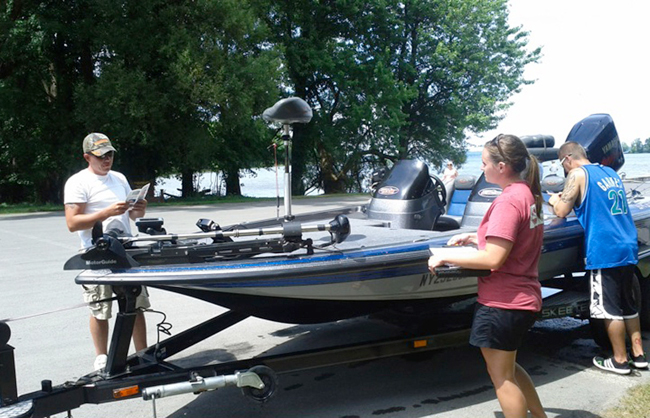By New York Sea Grant Launch Steward Shelby Persons
New York Sea Grant 2012 Launch Stewards Program
Contact: Mary Penney, NY Sea Grant, E:
mp357@cornell.edu, P:315-312-3042
NOTE: Since this article was written the U.S. Fish and Wildlife Service has identified Hydrilla in a section of the Erie Canal at North Tonawanda, NY, in September 2012.
Hydrilla verticillata is an aquatic invasive plant that devastates aquatic ecosystems and impact water activities such as fishing and recreation. Hydrilla, commonly known as water thyme, is very much a threat to local bodies of water, such as Oneida Lake, the Erie Canal, Lake Ontario, and the Salmon River.
Hydrilla is a submersed (grows underwater) aquatic plant that grows aggressively, creating thick mats that quickly cover an area. Stems grow up to 30 feet in length with 2-8 small toothed leaves in a whorl (spiral). When in bloom, the stems also have small floating white flowers.
Invasive Species Specialist Chuck O’Neill with Cornell Cooperative Extension says, “Hydrilla threatens native plants by blocking the sunlight they need to thrive. Decreased oxygen levels in Hydrilla infestations can lead to fish kills and reduce the size and survival of sport fish. Thick mats of Hydrilla can obstruct boating, swimming, and near shore fishing, leading to reduced shoreline property values. Hydrilla is not used by fish or waterfowl and therefore can eliminate or reduce the area of bird feeding and fish spawning habitat.”
Hydrilla was discovered in New York State in August of 2011 in the Cayuga Lake Inlet in Ithaca, NY. Hydrilla is believed to have been introduced to North America as an aquarium plant. It is likely that Hydrilla was released into the wild by people dumping their aquarium plants or draining water gardens into the local rivers and lakes, according to O’Neill.
The Cayuga Lake Inlet was closed to swimmers and boaters for a period of time after the initial Hydrilla sighting to decrease the chance of boats and their trailers spreading plant fragments to other bodies of water.
Allied Biological, a licensed and certified herbicide applicator, applied Endothall to the inlet to battle Hydrilla in mid-October 2011.This treatment was 95% effective and killed the plants enough to prevent tubers, the small structures that the plant uses for reproduction, from growing.
A second treatment was applied on June 26, 2012, to contain the Hydrilla to the edges of the inlet, out of the way of the boating channel.
The systemic herbicide applications will need to be continued for the next seven to eight years, as the Hydrilla tubers can lay dormant for 10 years. Treatment even two years after the tubers no longer appear is advised.
Cornell Cooperative Extension Tompkins County notes, “The waterways (of an area) affect the local economy in three primary ways; through flood protection, property tax revenues and tourism spending, particularly spending associated with recreational boating and water-dependent businesses. . . The economic vitality of the waterfront evolved based partially on a navigable waterway. An impairment that reduces the use, enjoyment or function of the waterway can be assumed to diminish its current and future economic value.”
According to the Hydrilla Task Force of the Cayuga Lake Watershed, “It cost about $91,000 (plus staff and volunteer time) to contain hydrilla this first year, and substantial investments will be needed for follow-up for the next five years or more to prevent a widespread infestation. Left unchecked, the cost to eradicate hydrilla in the Inlet will rise dramatically. States with widespread hydrilla infestations spend up to $30 million per year to contain hydrilla.”
Hydrilla is not considered ‘eradicated’ until there haven’t been any sightings in an area for three years. The Cayuga Lake Inlet’s resource managers will struggle combating the Hydrilla infestation there for the next decade, illustrating the importance of doing all we can to contain of slow the spread of Hydrilla into other New York waters.
What should property owners do if they think they have found a plant that may be Hydrilla?
Report the finding. Photograph and bag the suspect plant and hold for your local Partnership for Regional Invasive Species Management (PRISM) and or New York Department of Environmental Conservation office to inspect and identify. Take the plant’s GPS coordinates, or in some way documents its location, noting nearby on-shore landmarks.
The 2012 Launch Stewards program is a cooperative project managed by New York Sea Grant. For more information, contact New York Sea Grant at 315-312-3042,
www.nyseagrant.org/ccd.

NY Sea Grant Launch Steward Shelby Persons educates boaters about the importance of watercraft inspection to help reduce the introduction and spread of aquatic invasive species (AIS). A new video on how to inspect watercraft for AIS removal will post at
www.nyseagrant.org/ccd in September.
Photo: Matt Brincka, New York Sea Grant
This is the fourth in a series of articles by the New York Sea Grant Launch Stewards. The stewards are college students helping to educate water users and shoreline property owners about how they can help slow the spread of aquatic invasive species. The Launch Stewards located along Oneida Lake, the eastern shore of Lake Ontario, and at Salmon River Reservoir are part of a statewide project. Learn more online at www.nyseagrant.org/ais.